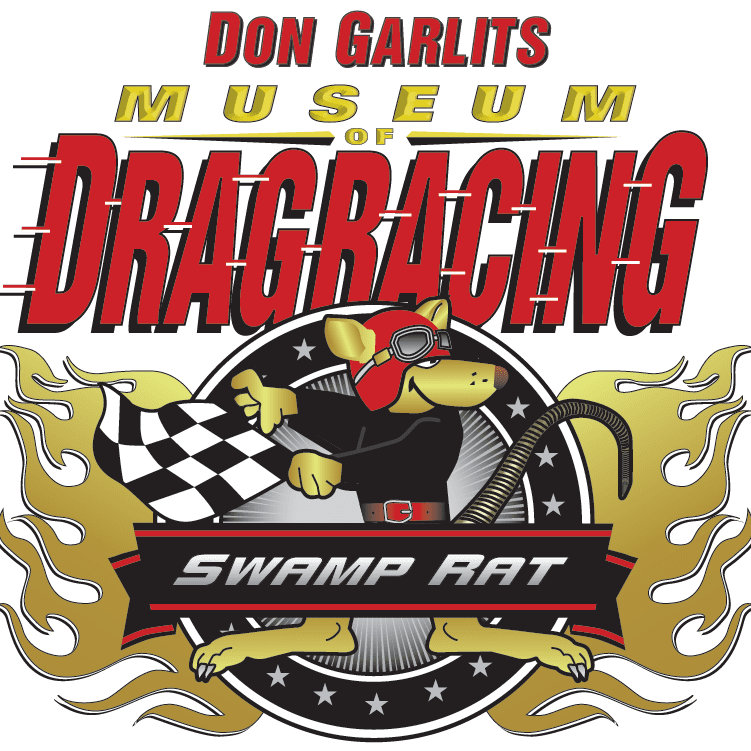2021
Thursday March 12, 2021 Wyndham Garden Hotel, Gainesville Florida.
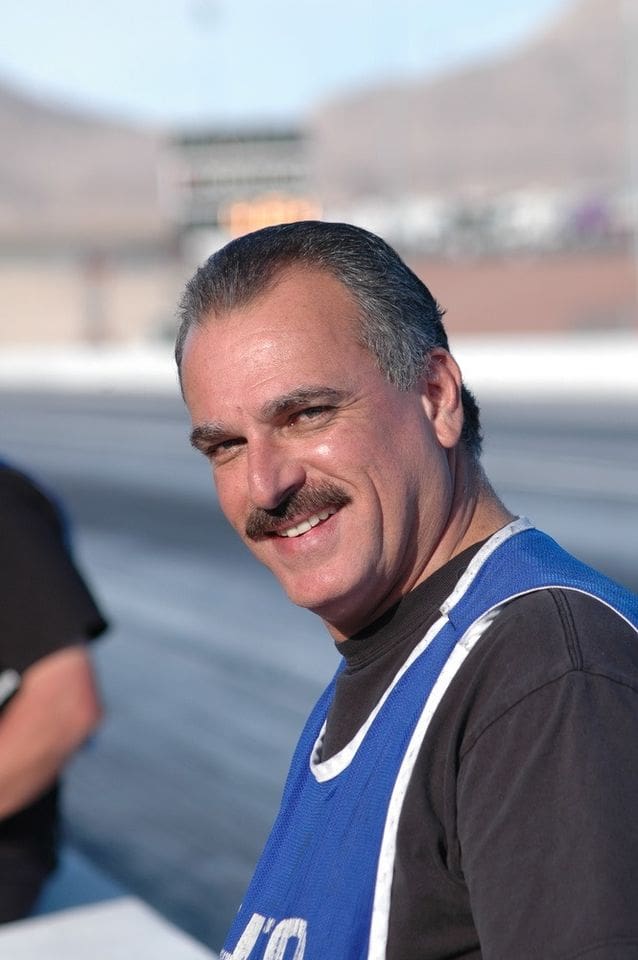
Bret Kepner
Like most of the people participating in the sport of racing and especially drag racing, Bret became interested in cars and the sport itself at an early stage of his life. However, unlike most of those involved, he has not believed it necessary to compete in a modified vehicle. His first race car was a stock 1966 Plymouth Barracuda entered into bracket racing. Since that start, he has competed in everything from roadsters, coupes, and dragsters to stock rental cars and has an impressive collection of trophies to show for it. One of his favorite forms of racing is to enter competition at a local track with rent a car and use driving skill to win the class.
While the racing itself is fun and interesting, Bret has not confined himself to that side of the sport. As a young enthusiast, he attended the University at St Louis majoring in Journalism and graduated with high honors. Since that beginning, Bret has had over 2,100 manuscripts published in magazines such as Super Stock Magazine and Super Stock & Drag Illustrated Magazine to name a couple. What is truly impressive is the fact that his works have appeared in a total of 57 major publications.
Next on his bucked list was to become a nationally recognized racing announcer where he has announced for NHRA, AHRA, IHRA, UDRA, NMCA, NMRA and ADRL at over 152 racetracks around the country. As if track announcing was not enough, Bret took on the job of TV host for IHRA in 1986 and continued with his TV participation, working for ESPN, FOX, NBC and CBS covering racing from the “inside” for 16 years.
In 1979 Bret continued to add to his expanding “job list” in racing by assuming the position of manager of Dragway 42 in West Salem, OH and in 1981 moving into the same position at St. Louis International Raceway. Still looking to add more ways to be involved, in 1989 he was named Director of the United States Super Circuit series and from 2003 through 2010 he promoted both the weekly Street Car Shootout Series and the monthly Outlaw All Star Series.
Still more levels of participation to be noted, in 1995 Bret opened the doors to his Bret Kepner School of Drag Racing that has graduated over 750 students. He has also researched and chronicled every drag racing facility ever built in a document to be placed in the National Archives for future historians.
Bret is a member of the Society of Land Speed Historians, was inducted into the East Coast Drag Racing Hall of Fame in Henderson, NC in 2007 and the St. Louis International Raceway/Gateway International Raceway Hall of Fame in 2008.
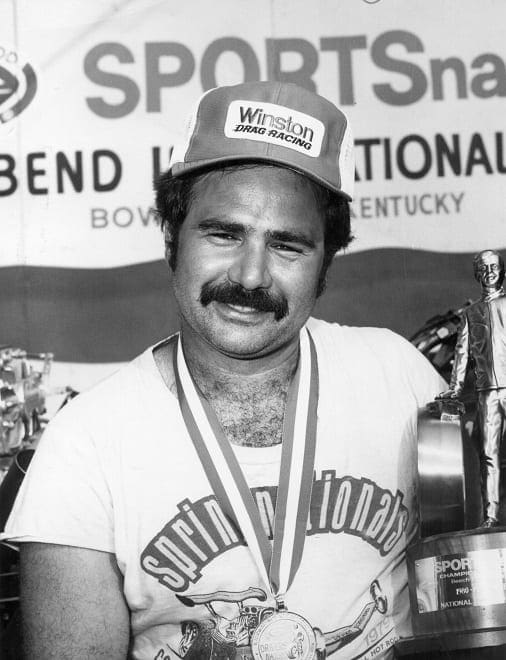
Frank Manzo
Frank spent his teenage years hanging out at a Sunoco station and whose owner campaigned a B/Modified Camaro at Old Bridge Township Raceway Park and where Frank caught the drag racing bug. In 1970 Frank began his racing career in the seat of his own ’23 T-bucket roadster with a carbureted small block Chevy furnishing its power. In 1972 he replaced the T-bucket with a Firebird Funny Car and the small block Chevy with a Supercharged Chrysler Hemi on alcohol and has been competing in that class ever since.
Racing was a part time hobby done locally at first but in 1975 he began competing at NHRA National Events. In 1976 Frank took ownership of a Ken Cox Monza bodied Funny Car and installed a Supercharged Chrysler Hemi on alcohol for power and moved closer to victory circle. By 1980, Frank had replaced the small block Chevy in the roadster with a Supercharged Chrysler Hemi, moved up into AA/Altered with the roadster and was able to score his first major National Event victory, the NHRA Sportsnationals at Beech Bend International Raceway in Bowling Green, KY.
Frank replaced the Cox Monza Funny Car with a Murph McKinney Monza bodied Funny Car in 1981 and installed his reliable supercharged Chrysler Hemi in it for power, fueled it with alcohol and won his first NHRA Alcohol Funny Car Championship. Very happy with his McKinney, Chrysler Hemi, alcohol combination, Frank had Murph build every one of his new cars from that time up to and including his last Monte Carlo bodied car in 2013. His next NHRA Alcohol Funny Car Championship win came in 1986 and that Championship was followed by wins every year from 1997 through 2003 and again with wins every year from 2005 through 2013. To say that Frank was, and still is, a dominating force in Alcohol Funny Car is an understatement.
Moving into the international arena of the sport, in 2009 Frank signed on with Qatar’s Sheikh Khalid Bin Hamad Al Thani’s Al-Anabi Racing program where he not only competed under the Al-Anabi banner with his Chevrolet Monte Carlo Alcohol Funny Car, he also helped develop the team’s overall strategy both in the US and Qatar.
During his career Frank has notched 17 NHRA Top Alcohol Funny Car Championships, 118 NHRA class Divisional wins and 105 NHRA National class wins. He was also able to be the number one class qualifier at NHRA National events 100 times, set and reset the Low Elapsed record 121 times and did the same for the top speed record 139 times. He is also ranked number 40 on the NHRA 50 Greatest drivers list.
While Frank is retired from driving, he is still in great demand as a tuner and engine builder for the Funny Car and Pro Mod classes and still actively mentors young people entering the sport every opportunity he gets.
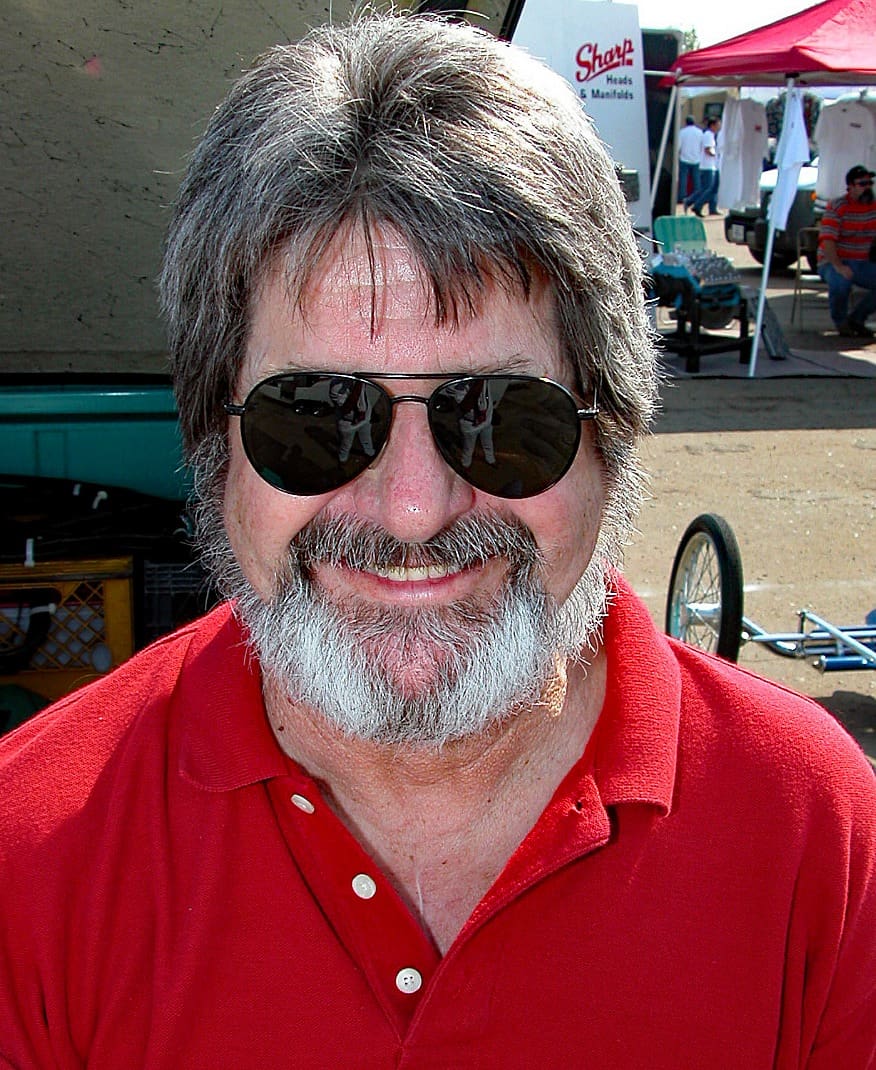
John Austin
John ‘Tarzan’ Austin grew up as a typical Southern California boy in the 1950’s. He was interested in cars and speed long before he was able to obtain a driver’s license but when he did get his license, his first car was a 1937 Chevy four door sedan. At the age of 16 John was able to join one of the more recognized car clubs in So Cals San Fernando Valley, the Throttle Merchants. Most of the club’s members, including John, were to be found at the local drag strip every weekend, competing for trophies, and learning how to build and drive a modified car. John was no different and if you really wanted to find him, just show up at one of the racetracks on a Saturday or Sunday.
In 1960 John got his first ride in a true race car when Ted Worby, another Throttle Merchants member, let him drive his supercharged Chrysler Hemi powered AA/Gas dragster. However, unlike most of his fellow club members, John was not employed in the automotive arena but as a bouncer at a local Valley bar. This along with his physical appearance, strength and his unique voice earned him the nickname “Tarzan” that has stayed with him over the years.
Over the years, two of the major car clubs headquartered in Southern California’s San Fernando Valley were the Road Kings and the Throttle Merchants but John bridged the gap between the two when Road King member, Tommy Ivo sold his 4-engine powered dragster to another Road King member, Tom McCorry. At the beginning of the 1963 racing season, McCorry asked John to go on tour with him as his crew chief but Ivo learned about the arrangement and managed to talk John into going on tour with him instead. This was the start of a long time “touring team” arrangement between John and Ivo with both of them working on the car. Ivo was team owner and driver, but John took over responsibility for maintaining the car and sharing the driving chores of the tow rig.
In 1971, John teamed up with Arnie Behling who was campaigning a AA/Fuel dragster known as ‘The Sprite Team’ as his crew chief. As crew chief and tuner, John helped tune the car into the winner’s circle at the NHRA Summernationals in Englishtown, NJ. In 1972 John moved to Greg Scheigert’s Hot Tuna AA/Fuel dragster camp and fulfilled his longtime dream of driving a nitro burning dragster as well as assuming the Crew Chief position for the team. John held that job until 1974 when the car’s engine exploded during a qualifying run and he crashed the dragster at the Gatornationals in Gainesville, FL and Scheigert retired from racing.
In 1975 John not only moved to another team, he also moved from the AA/Fuel dragster class to the controls of a AA/Fuel Funny Car, the supercharged Chrysler Hemi powered Vega that was being campaigned as the Bluegrass Shaker. The team was able to finish second in the NHRA Division 3 championship points that year but a massive engine explosion and fire near the end of the season left John with his hands burned and no ride and, which helped him decide to retire as a driver and stay involved as a crew member for various teams.
After that, John went to work at Raymond Beadles Chaparral Trailers in Dallas, TX where he learned to build trailers for a lot of his racer friends. Over the years John has stayed in touch with most of his racer buddies and helped bring a lot of laughs to their “social gatherings” but he also helped bring a lot of new ideals and great publicity to the sport.
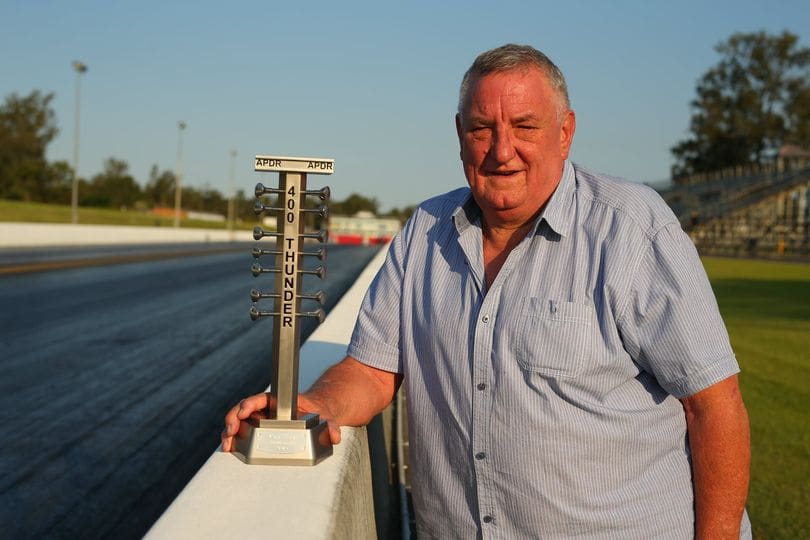
John WInterburn
John “Stomper” Winterburn was one of the pioneers of Australian drag racing. He was also the longest serving official in Australian drag racing with over 47 years as a fulltime participant. John officially began his journey into drag racing in 1966 when he assisted at the opening event at Surfers Paradise International Raceway.
John joined the local Holden Car Club in his early teens which was more of a sports car arena but as fate would have it, there was a car show scheduled across the highway from Surfers Paradise on the same day of its grand opening and Stomper had entered his brother Bobs car in that show. The track officials asked if the club members would lend a hand for the opening and that was the beginning of Stompers drag racing involvement.
John readily admitted he was never interested in being an on-track competitor but he was fascinated by the skill and efforts it took to make a racetrack operate smoothly. He continued working at the track in various roles until 1972 when the director of Surfers Paradise resigned to become the director of Savannah Dragway in Townsville, Australia. John took over the reigns as the track’s meeting director at that time, a position he would fill for 15 years.
In 1981 it became obvious to all involved that Surfers Paradise could not survive as a racetrack so along with a group of like-minded enthusiasts, John formed a committee of seven to establish a new venue for the sport. The result of this effort was Willowbank Raceway in Queensland, Australia. As a show of their belief in this project, the seven committee members actually pledged their houses as collateral for the bank funding for the project.
John was named Meeting Director of Willowbank Raceway from its opening in 1985 and remained in that position until his retirement in 1999. While he was involved with the racing world, John earned his living as a pastrycook at the nearby Websters Biscuit Factory where he was the assistant production manager. In addition to his participation at Willowbank Raceway and Webers Biscuit Factory, John was very involved in the Dragfest program that was instrumental in bringing U.S. racers to compete in Australia. John’s commitment to this project was so strong that in 1974 he took leave of his Webers job and moved to the States for six months.
During his first time living in the States, John moved in with Bill Shrewsberry and became a part of his crew for Bills wheelstander car. This gave him the opportunity to meet a lot of the racers and to become aware of their involvement in drag racing. After going home to Australia, John decided to quit his job at Webers and opened a snack bar in Bowen Hills, Australia. This provided John with the funds to continue his commitment to Willowbank and the Dragfest program and help build it into a regular annual feature for both the racetracks and the U.S. racers. John soon became the main source for bringing together the U.S. racers who wanted to compete in Australia and the tracks that wanted to book them.
John was also chairman of the Queensland Hot Rod Association and was responsible for producing hot rod shows at various venues including racetracks. In 197__, John’s lease on his snack bar ran out and because of his involvement with the Dragfest and the Hot Rod events and the amount of travel involved for them, he opened his own travel agency.
Over the years John was responsible for U.S. racers such as Leland Kolb, E.J. Potter, Bill Shrewsberry, Gary Densham and John Force to name a few making the trip to Australia. He was also responsible for several Street Rod folks making the ‘down under’ journey and, helped the entire sport of drag racing develop into a strong venue in Australia. One last note, John admitted that his nickname Stomper was because of his large size 13 shoes.
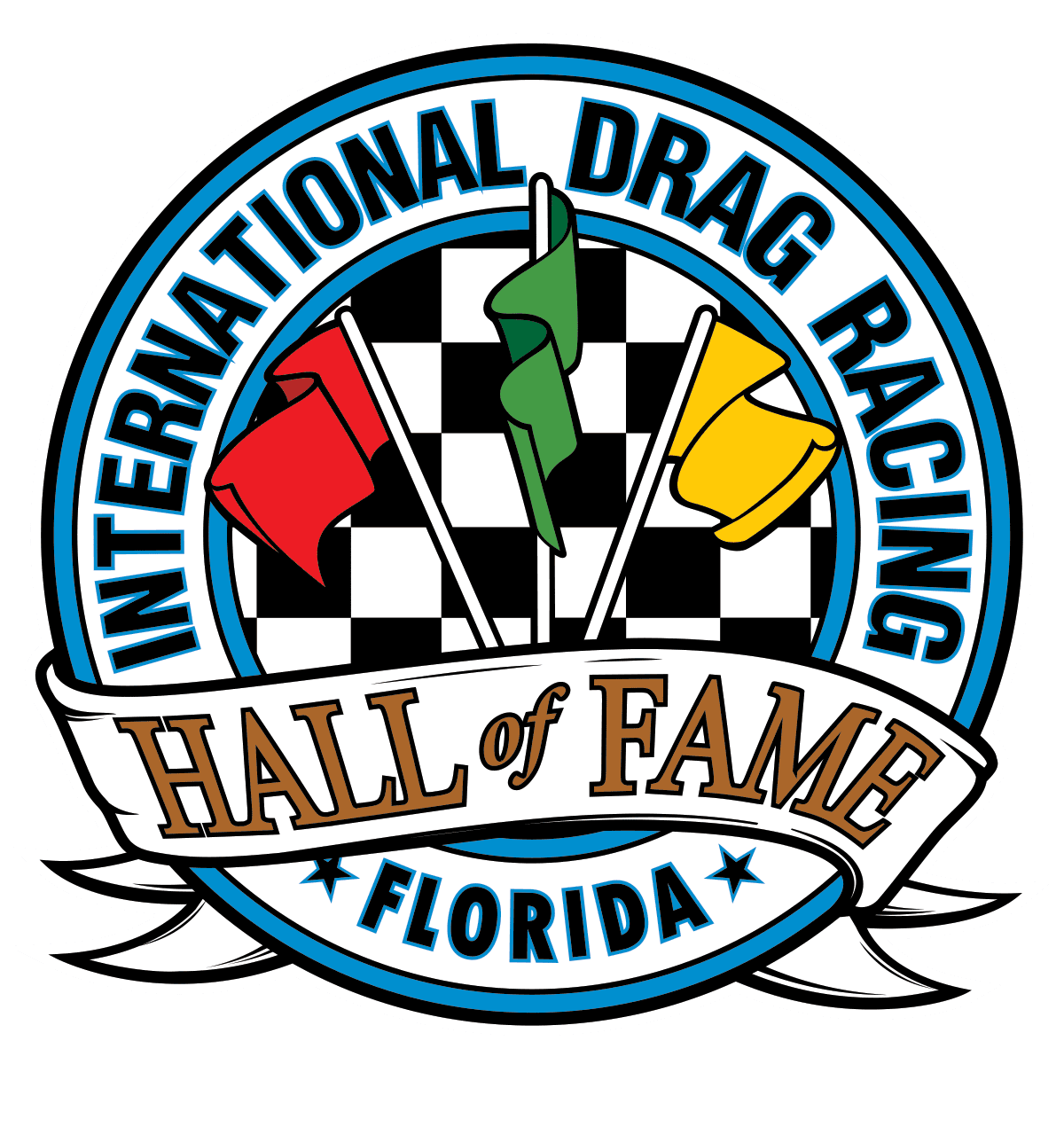
Laura South
Her passion, people skills and organizational expertise likely would have made Laura Earwood South a success at anything she attempted. Fortunately, it was the sport of drag racing that realized the greatest benefit over the course of an outrageously diverse career that began with the NHRA, included a 20-year stint as Executive Vice-President and General Manager of the former Moroso Motorsports Park in West Palm Beach and continues today through work with charitable and civic organizations in and around Palm Beach County.
A Texas native who admittedly knew nothing about auto racing when she moved to Atlanta in 1974, South got a crash course from Steve Earwood, the former National Media Relations Director for the NHRA to whom she once was married, with whom she briefly owned Atlanta Dragway, helped pen Teas Motorplex, and alongside whom she traveled the national event circuit for 13 years. During that time, she assisted in formulating and executing marketing, publicity and promotional campaigns at NHRA national events from Gainesville to Seattle, New York City to Los Angeles, while at the same time making a host of industry contacts that later would prove invaluable.
Laura was one of the founding members of DRAW (the Drag Racing Association of Women), an organization that today continues to provide assistance to injured racers and their families, she has worked enthusiastically in support of women in all forms of motor racing, including licensing and working on public relations and publicity with Elaine Larsen, the two-time IHRA jet car world champion.
Although she developed and honed her skills in drag racing, South’s success has been anything but one-dimensional. She has worked in the retail, public involvement, fundraising and insurance industries, was involved in the promotion of events in the IMSA road racing series, the SCCA Trans Am series and worked with the late Raymond Beadle’s Blue Max team when driver Rusty Wallace won his only NASCAR Cup championship.
After developing a friendship and working relationship with the late Dick Moroso, for whom she helped coordinate promotions and publicity in support of independent drag racing events (including the Citrus Nationals and the Five-Day Bracket Race) at both Moroso Motorsports Park and Miami-Hollywood Dragway, she was hired by the Hall of Fame racer, manufacturer and track owner as Executive V-P and GM of his racetracks in 1987.
In that capacity, she was directly involved in facility development and maintenance, the initiation of community outreach initiatives, sponsor development, creation of new events and oversight of the marketing, PR and publicity effort while at the same time managing a full-time staff that produced more than 500 diverse events each year. In 2006, MMP entertained more than 650,000 visitors and pumped an estimated $50 million into the local economy, earning the prestigious Providencia Award presented annually by the Palm Beach County Chamber of Commerce as a result.
When the family opted to sell the track after Dick Moroso lost his battle with cancer in 1998, South embarked on a new challenge as an independent event planner and advocate for a variety of causes and individuals, serving, among other things, as president of the John Paul Jr. Huntington’s Disease Foundation. She is a past member of the Palm Beach County Business Development Committee, the Palm Beach County Convention and Visitors Bureau, the South Florida Blood Banks, and the board of a Palm Beach County Attractions Association that she formerly chaired. She also is a member of three Chambers of Commerce and serves on the Board of the Palm Beach County Sports Commission and Hall of Fame.
As an event planner whose moto is “we take fun seriously,” she has produced concerts, air shows, seminars, conferences and trade shows. Among her favorite were the Wine & Dine on the Boardwalk, an auction, gala and golf tournament benefitting Grassy Waters Preserve, a Wine & Dine event for the Palm Beach Gardens Athletic Association, a College Game Day festival in downtown West Palm Beach and the All About You conference for women that in 2015 and 2016 benefitted Burckle Place (for single, homeless women) and Place of Hope (a haven for abused children and their families).
Married the last 26 years to Regional insurance executive Bill South, with whom she resides in Stuart, Fla., she is active in Peace Presbyterian Church, serving faithfully as both an elder and fellowship leader.
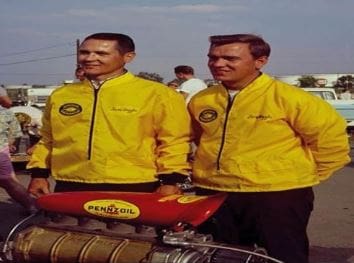
Ron & Gene Logghe
Gene and Ron Logghe were like most of their generation; they loved cars and racing. One thing Gene and Ron had over most other car enthusiasts, their father, Morris Logghe, owned the Logghe Stamping Company. Both Gene and Ron worked at Logghe Stamping, a company that produced products for the auto industry. Since they worked at the stamping company, both Gene and Ron became skilled with their hands as well as their minds.
Both brothers wanted to start racing. Ron designed and built a sports car for road racing and they soon realized road racing was above their budget. But, in 1958 they attended their first drag race and were instantly captured by what it offered, and it was affordable.
Soon, they revamped the sports car for Ron to drag race and built a tube chassis roadster for Gene. In 1961 a local racer named Connie Kalitta asked if the Logghe brothers would build him a dragster chassis. Since the Logghe’s had the equipment and the knowledge, they built thier first Logghe dragster chassis. Connie had great success with this car, and others began to ask if they could purchase one of these chassis. With the chassis business taking off, the Logghe’s expanded into clutch cans, steering components, and axles to go with their chassis. Ron had come up with a new chassis design, small and ultra-lightweight dragster. While testing the car, Gene got burned and their father forbid the brothers to drive a dragster anymore.
Jim Marsh and Roy Steffey, employees at the Logghe Stamping, were having great success in their nitro injected chevy Logghe dragster. The four paired up, forming the Logghe, Marsh & Steffey team with Jim Marsh as driver. In 1963 and 64, the four began to win events and set records wherever they showed up. They beat so many top contending AA fuel dragsters at the time, the car earned the name “the giant killer.” Orders for the Logghe dragsters began to pour in, and soon the Logghe Competiton Products division was formed for the sole purpose of building racing cars and race-related products. The Logghe’s started work on another new design, “the Streamliner,” a sleek streamline body covering a Logghe chassis to cut through the wind. The streamliner did not prove to work out, and in 1965 the Logghes return with “the Prussian,” a blown Chrysler dragster driven by Maynard Rupp and tuned by Roy Steffey. The team went on to win the first NHRA points championship.
This caught the attention of Fran Hernandez and Al Turner with Lincoln-Mercury, who approached the Logghes to build a series of cars to beat the Chrysler altered wheelbase funny cars in the factory experimental class for 1966 (aka the funny car). Logghes came up with a tube chassis with coil-over shocks and featured a one-piece flip top body. The new Ford 427 SOHC would power the cars. The flip-top funny cars had instant success. This led to a stampede of new customers wanting a logghe funny car.
By 1967 drag racing had become a big business for Logghes, and it was not uncommon for at least one newly built dragster and one completed funny car to leave the Logghe shop in a week. Racers at heart, Gene and Ron Logghe promoted both Dragsters and Funny Cars though out their carreers. Many Great names in drag racing won with Logghe race cars such as Tom Prock, Jay Howell, Chuck Kurzawa, Connie Kaliita, Gene Snow, Al Bergler, Shirley Muldowney, Poncho Rendon, Arnie Beswick, Bob Pasccito, Roland Relong, Willie Borsch,” Jungle Jim” Leiberman, and Jack Chrisman, to name a few.
The Logghe Stamping Company turned out over 600 race cars, including Pro Stocks, Altereds, Dragsters, Funny Cars, Motorcycles, Cars and Motorcyles for Bonneville, and even Go-Carts.
With countless wins over the years for Logghe’s, The Logghe Stamping Company was named Car Craft Magazines Funny Car Chassis Builder of the Year in 1967, 68, 69, and 70. In 2006 the Brothers were Honored by the NHRA Hot Rod Reunion, and in 2010 they were inducted into the Michigan Motorsports Hall of Fame.
The doors closed the doors on the famous Logghe Stamping Company in 2013. Gene Logghe still resides in Michigan; Ron Logghe passed away on May 27, 2020.
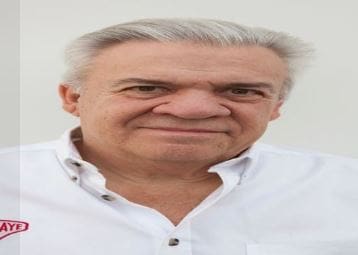
Terry Cook
Terry started drawing cars when he was six years old and graduated to building models a few years later. As soon as he got his driver's license, he joined the local hot rod club. His first car that ran was a Chevy powered C dragster but rather than become just another racer, his love of cars and speed got him a job as the flag starter at Island Drag Strip in Great Meadows, NJ. When the Christmas Tree took over his job as flagman, Terry became the track reporter and fell in love with the world of automotive journalism.
In 1964 Terry turned started producing a column New Jersey News (for $5/week) for Drag News under the byline “Broomfoot”. This gave him nationwide presence and established his name. In 1965 Terry hitched a ride to the West Coast with Chris Karmesines and wound up moving there to become the Associate Editor at the weekly newspaper, Drag World. Terry’s editorial talent was soon recognized by the folks at Car Craft Magazine and in 1966 he became a feature editor there. By the time Terry completed his reign at Car Craft Magazine, he had assumed the position of Editor. While Cook was there Car Craft doubled its circulation from 180,000 to 360,000. Petersen management tapped Terry for the Editor in Chief position at Hot Rod Magazine where again his talents contributed to a growth in readership. While part of Terry’s success came from finding outstanding journalists and hiring them, he also had a knack for “stirring the pot” with controversial subjects such as how the racers were treated by the Racing Associations, what was “hot” from Detroit.
While Terry was an avid drag race fan and supporter, after witnessing several drivers being involved in fatal accidents, he turned his attention more toward the Hot Rod and Custom Car world. Because his wife disliked earthquakes in 1975, he moved back to Jersey and teamed with Phil Engeledrum to start their own publication, Vans & Trucks Magazine. Before long there were so many publications aimed at that market, they closed the doors on Vans & Trucks Magazine and Terry became a staff writer for Car and Driver Magazine and also founder of a trade magazine, T-Shirt Retailer, aimed at the trinkets and t-shirts market.
In 1983 Terry moved into another arena of the automotive world, producing car shows. His first plunge into this world was titled, LEAD EAST, Worlds Biggest 50’s Party. It is a five-day long event that and was focused on 1967 and earlier cars and is still an ongoing annual event.
Today, Terry is as well-known for the custom cars he has designed and had built, among them his 1939 Lincoln Zephyr Scrape. In 2019, Terry was named the featured designer at the prestigious Eyes on Design car event in Grosse Point Shores, MI. Terry is active in all arenas of the automotive world and is still willing and able to work to help every form of racer and racing activity receive a fair shake.
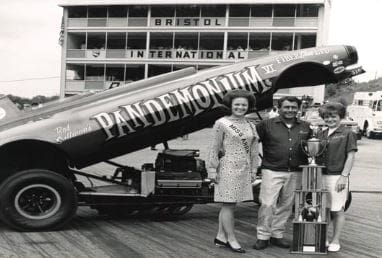
Bob & Shirley Sullivan
Bob and Shirley Sullivan were husband and wife but beyond that, they were a team in everything they did. In the early days of drag racing, while most race teams are a group of guys who got together and pooled their resources, Bob and Shirley made up their famous Pandemonium race team. Bob was the chief mechanic, technical expert and driver and Shirley was the pit crew and business manager.
Both of them fell in love with high performance cars and speed in their teens so it was no surprise that after they got married, they began doing a bit of street racing. Their first car was a 1941 Plymouth with a mildly modified engine. This was followed by a series of Plymouths and Oldsmobile's, but they soon realized it was much better to take their racing off the street and into an organized event.
In 1951 they built their first competition roadster, a 1931 Ford roadster body on a channel 1932 frame with a carbureted Oldsmobile for power and began competing at the local drag strip. In 1953 they helped form “The Dragsters”, the first sanctioned car club in Kansas City, KS. In 1954 the Dragsters joined with another local car club to form the Kansas City Timing Association to help provide a safe, organized racing entity and to generate a greater interest in the sport locally.
Bob and Shirley moved up to the “fuel dragster” world in 1954 with a Rod Stuckey set of rails powered by a carbureted Oldsmobile engine and acquired their first major class win at the NHRA Midwest Regionals in Scribner, NE where they also set top time at 123.49 mph. Another major change for them at this time was they switched from the Oldsmobile engine for power to a Chrysler Hemi with great success.
In 1955 Rod Stuckey built their first all-aluminum full-bodied A/Fuel dragster with a carbureted Chrysler Hemi engine for power, the first in a series of beautiful and extremely competitive cars. This was the car that in 1958 Bob drove to new 1/4-mile World Record speed and ET records of 185.56 mph and an 8.39 ET.
In 1959, Bob and Shirley made the decision to become full time professional drag racers and competed in the entire Drag News Invitation Tour. In 1960 they posted their first National Event win, the AHRA Summer Nationals in Kansas City, MO. This is also the first car to be fielded under the Pandemonium name which came about according to Shirley because of the commotion generated by their original gas dragster. The car that provided this win was another Rod Stuckey chassis with a carbureted Chrysler Hemi for power and that moved them up to AA/Fuel Dragster class. At the 1961 AHRA Summer Nationals in Green Valley, TX they set new AHRA records in both ET and top speed with an 8.21 ET and a top speed of 184.04 mph.
They fielded AA/Fuel Dragsters under the Pandemonium name through the end of the 1964 season and became pioneers in the Funny Car arena in 1965 when they fielded a 1965 steel bodied Barracuda with a Supercharged Chrysler Hemi on nitro for power.
1967 saw a change in bodies from the Plymouths to a Camaro Roadster with their proven Supercharged Chrysler Hemi on nitro for power and it also saw them notch the first ever 190 mph speed for a Funny Car with a speed of 193.12 mph.
Bob and Shirley campaigned a total of five Funny Cars from 1965 until they retired from the sport in 1974. Along the way they managed to set National & World speed and ET records for both the ¼ mile and 1/8th mile, win the AHRA 1/8th mile Championship twice, the AHRA Winter Nationals twice, in 1963 and 1964 and the NHRA Spring Nationals in 1968. It should also be noted that four young men, Glenn Leasure, Rod Stuckey, Jimmy Nix and Ron Goodsell, were able to gain driving experience when Bob took a break from driving at various times and put them in one of their cars.
